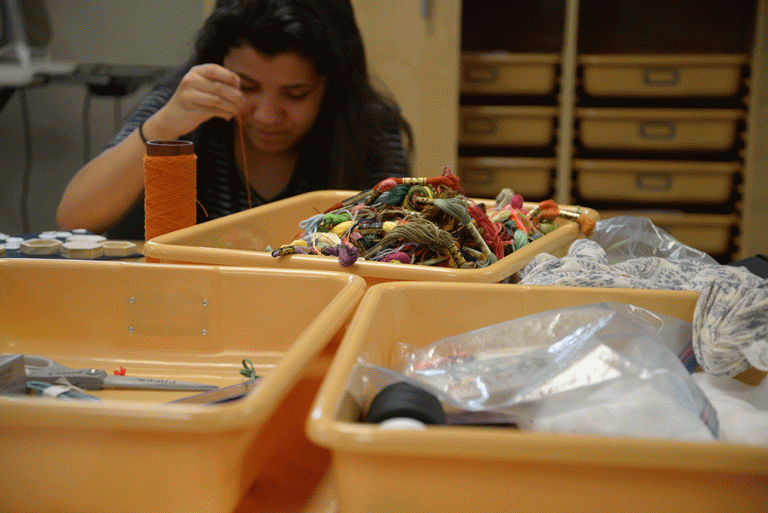Greenville’s Textile Industry Gets a Boost from New Fiber Arts Program
New fiber arts program at the Fine Arts Center prepares students for emerging jobs in thriving textile industry

Textile artist April Dauscha was given an offer she couldn’t refuse. The opportunity to build and shape a brand-new curriculum at a first-of-its-kind school in the largest school district in South Carolina.
A Promising Proposition
“The idea of the program was originally conceived by Dr. Roy Fluhrer [director of the Fine Arts Center] and I came into the picture after a national search went underway in the winter of 2016. After making it through the first round of interviews, I was asked to come to Greenville for a visit – I walked away from that visit wowed by the work being produced by the students in the Visual Arts Department and was incredibly charmed by this quaint city of Greenville. After I got the call and was offered the job, it was hard not to say yes!,†Dauscha says.
The program is fiber arts design; the school is the Fine Arts Center of Greenville (FAC), the state’s first school exclusively dedicated to fine arts education. Dauscha teaches her students about fabric formation, such as weaving and knitting and about surface design and production processes, such as screen-printing and apparel construction. Students supplement the fiber arts program with courses in drawing, photography and design, and upperclass students are also encouraged to attend a textile exploration program at North Carolina State University, the nation’s premier university for textile arts and a sponsor of the FAC program.
“This program is allowing the students to gain direct access to the industry so they can see first-hand that this career path is relevant and continues to thrive despite its reputation,†Dauscha says. “The students are thrilled to be a part of the new program, and the parents have been incredibly supportive. We have two students that are now off to NC State’s College of Textiles and a cohort of students next year who are planning to further their studies in textiles and fiber arts. I’m excited to start seeing the results of the program over the next several years, what these students go on to achieve, and how they’ll bring that back to Greenville.”
Art and Industry
Dauscha herself has a long history in textile design. A Louisville, KY, native, Dauscha majored in fashion design at the International Academy of Design and Technology and then pursued a master’s of fine arts degree in fiber from Virginia Commonwealth University. She went on to teach fiber pattern weaving at Virginia Commonwealth and wearable sculpture at the Chicago High School for the Arts. Her own works in lace have won multiple awards and have been exhibited at Fiberart International and the Muskegon Museum of Art.
As an artist and instructor, Dauscha was well aware how beneficial this new program could be for students. What she didn’t know, however, was how important this program would be to the city’s economy.
“The textile industry is incredibly important to Upstate South Carolina – it is the very foundation that this city was built on. Before moving to Greenville, I had the perception that the textile industry was completely dormant in the United States after moving most of its production overseas,†she says. “But after heading this program and interacting with the vast local industry, it has completely changed my perception. The industry is alive and well in the Upstate, and I’d even say it’s thriving along with the city of Greenville.”
In fact, in the 1950s and ’60s, Greenville was dubbed The Textile Capital of the World. Even after a national industry downturn, many of Greenville’s longtime industry leaders – Sage Automotive Interiors and Southern Weaving to name a few – remained. Today, the industry thrives, employing thousands and pumping millions of dollars into the city’s economy.
“As the instructor of the Fiber Program, I find ways to collaborate with the industry directly. I have worked with companies like Glen Raven and Springs Creative to create textile design competitions with my students – the winner of these competitions end up with cash awards or scholarship money, and walk away with an understanding of what it takes to work in the textile industry,†Dauscha says.
“Additionally, we have worked with Sage Automotive Interiors to establish an annual summer design internship for one of the fiber students. This internship is a totally immersive experience where they are a part of the design team, creating textile design ideas, giving feedback in department critiques, and visiting the production facilities to see these designs come to life.”


